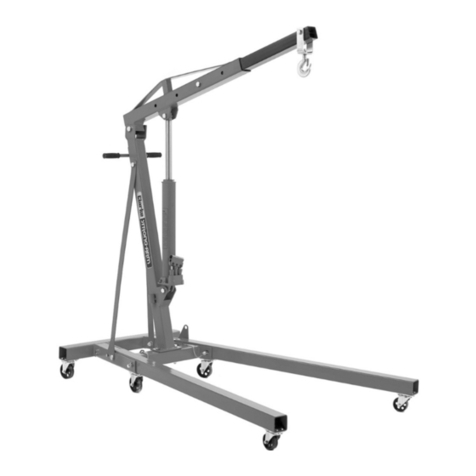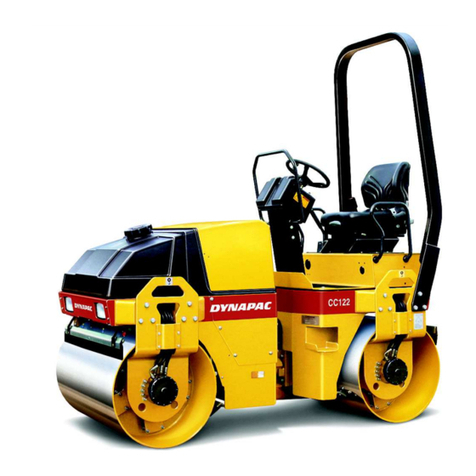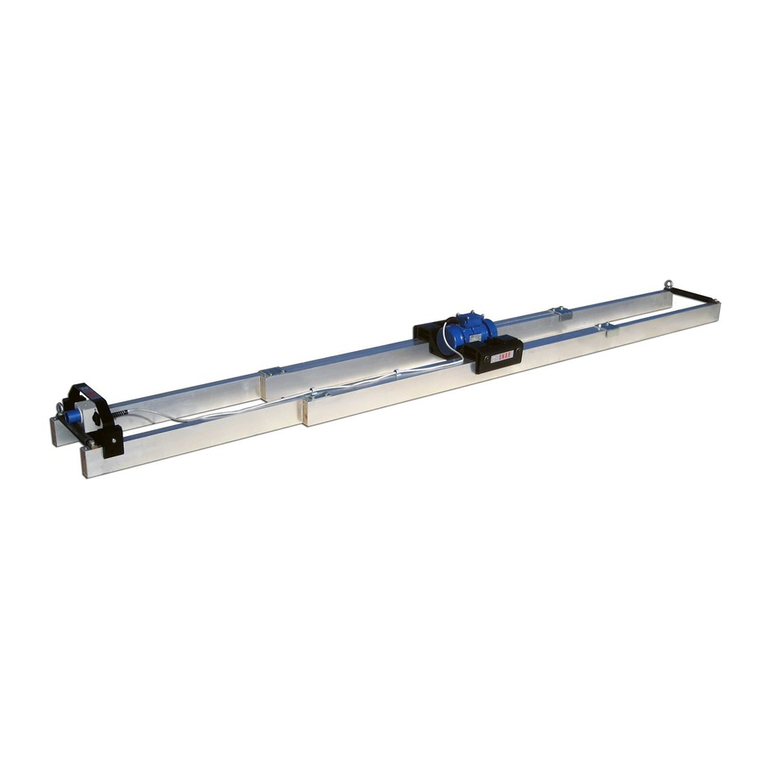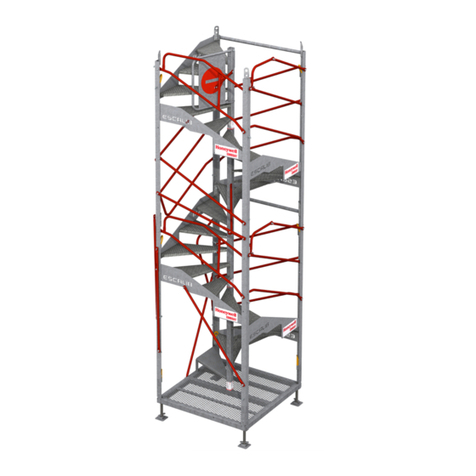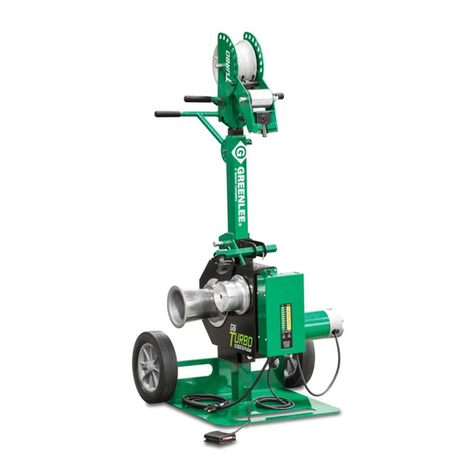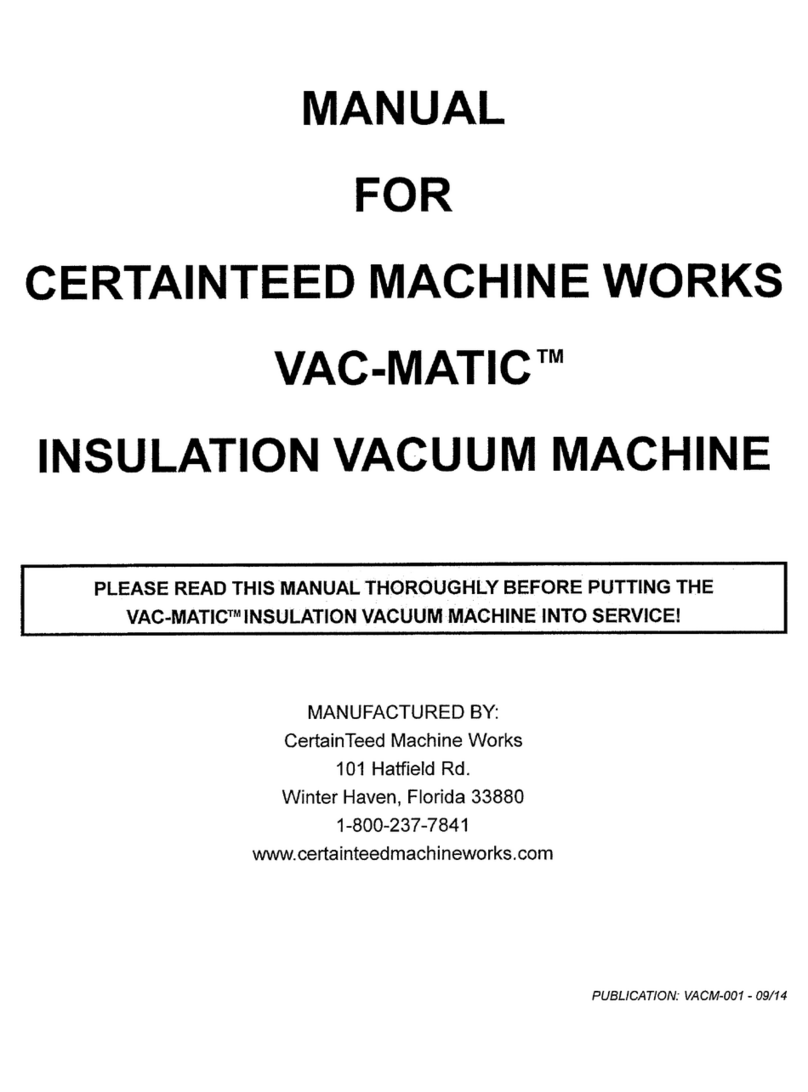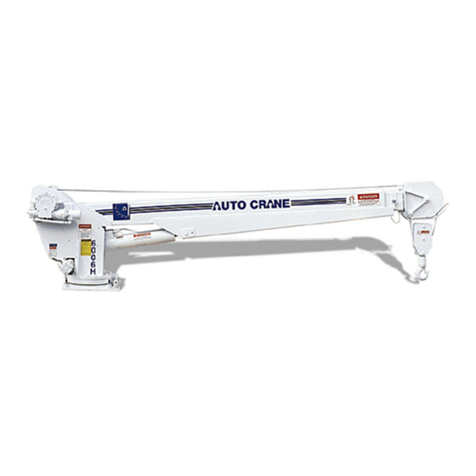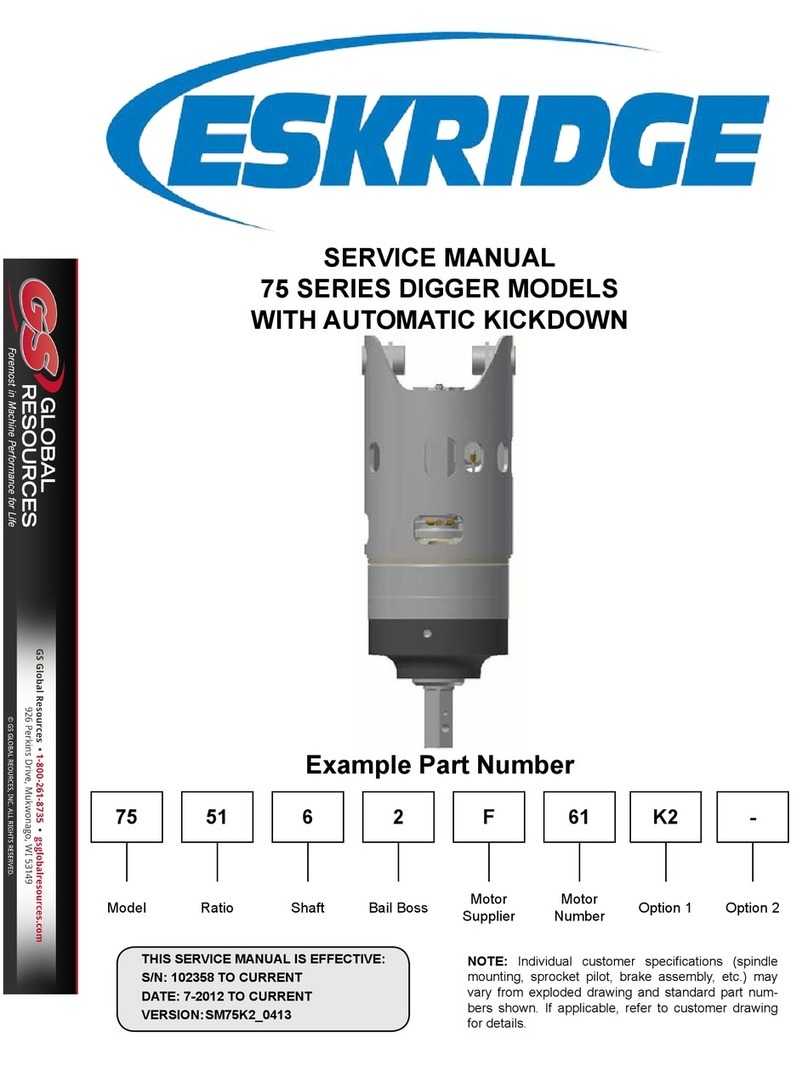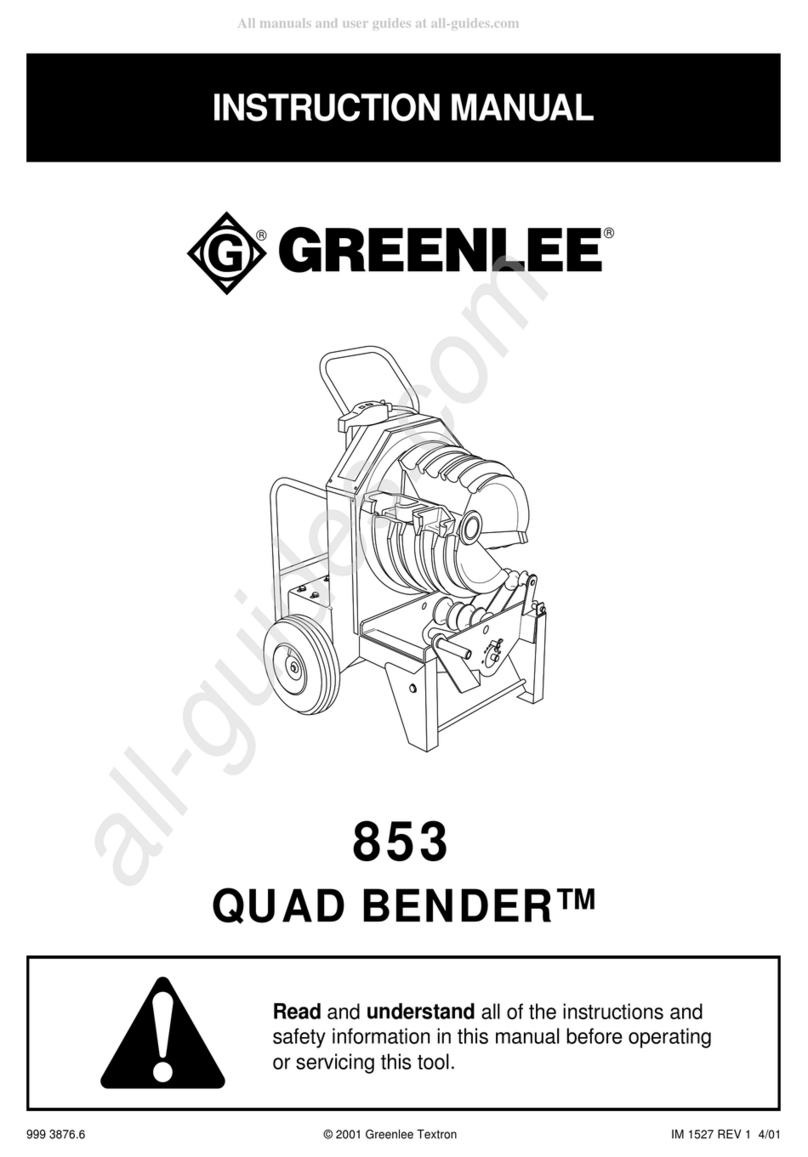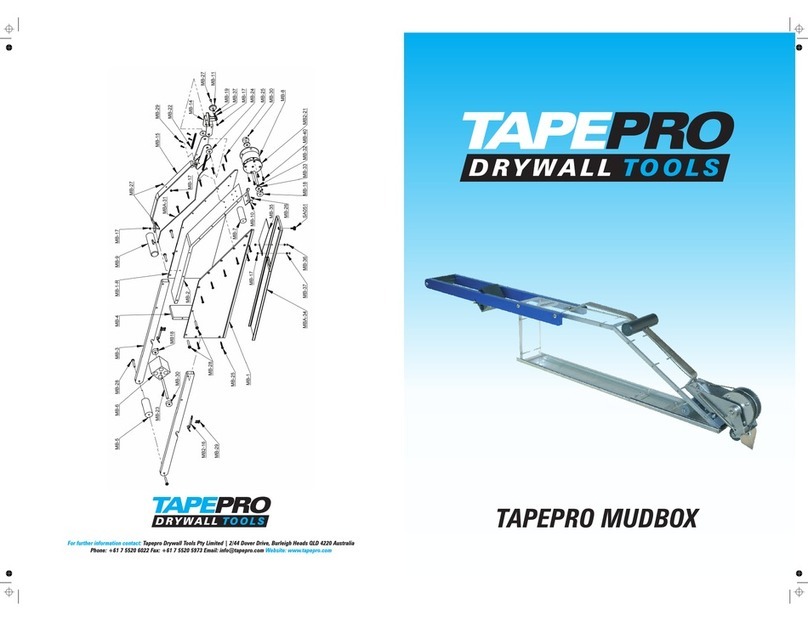SpanDeck MANTIS 8010 User manual

REV: DATE:
OPERATOR’S MANUAL
FOR THE
MANTIS™MODEL 8010
40-TON DIESEL-POWERED,
HYDRAULICALLY-OPERATED
CRAWLER CRANE
View thousands of Crane Specifications on FreeCraneSpecs.com
View thousands of Crane Specifications on FreeCraneSpecs.com

ii
REV: DATE:
TABLE OF CONTENTS
1. OVERVIEW . . . . . . . . . . . . . . . . . . . . . . . . . . . . . . . . . . . . . . . . . . . . . . . . . . .1
Manual Organization . . . . . . . . . . . . . . . . . . . . . . . . . . . . . . . . . . . . . . . . . .1
Operator Alerts . . . . . . . . . . . . . . . . . . . . . . . . . . . . . . . . . . . . . . . . . . . . . .2
Directional References . . . . . . . . . . . . . . . . . . . . . . . . . . . . . . . . . . . . . . . .2
Capacity Limits and General Conditions . . . . . . . . . . . . . . . . . . . . . . . . . . .2
Lubrication and Maintenance . . . . . . . . . . . . . . . . . . . . . . . . . . . . . . . . . . . .3
2. DASH/CONTROL PANELS . . . . . . . . . . . . . . . . . . . . . . . . . . . . . . . . . . . . . . . .5
Engine Controls . . . . . . . . . . . . . . . . . . . . . . . . . . . . . . . . . . . . . . . . . . . . .6
Swing Right/Left Controls . . . . . . . . . . . . . . . . . . . . . . . . . . . . . . . . . . . . . .8
Telescope Out/In Control; Auxiliary Winch Control . . . . . . . . . . . . . . . . . . . .9
Main Winch/Boom Hoist Controls . . . . . . . . . . . . . . . . . . . . . . . . . . . . . . .10
Travel Controls; Tracks Extend/Retract Switch . . . . . . . . . . . . . . . . . . . . . .11
Auxiliary Equipment Controls . . . . . . . . . . . . . . . . . . . . . . . . . . . . . . . . . . .12
Other Operator Controls . . . . . . . . . . . . . . . . . . . . . . . . . . . . . . . . . . . . . .13
3. LOAD MOMENT INDICATOR/ANTI-TWO-BLOCK SYSTEM . . . . . . . . . . . . . .15
Load Moment Indicator . . . . . . . . . . . . . . . . . . . . . . . . . . . . . . . . . . . . . . .15
Load Chart Selection & Load Moment Indicator Setting . . . . . . . . . . . . . . .15
Anti-Two-Block (A2B) . . . . . . . . . . . . . . . . . . . . . . . . . . . . . . . . . . . . . . . .16
4. ENGINE OPERATION . . . . . . . . . . . . . . . . . . . . . . . . . . . . . . . . . . . . . . . . . .17
Alarm Systems . . . . . . . . . . . . . . . . . . . . . . . . . . . . . . . . . . . . . . . . . . . . .17
Walk-Around Inspection . . . . . . . . . . . . . . . . . . . . . . . . . . . . . . . . . . . . . . .17
Electric Starting . . . . . . . . . . . . . . . . . . . . . . . . . . . . . . . . . . . . . . . . . . . . .19
Starting With Jumper Cables . . . . . . . . . . . . . . . . . . . . . . . . . . . . . . . . . . .20
After Starting The Engine . . . . . . . . . . . . . . . . . . . . . . . . . . . . . . . . . . . . .21
Engine Stopping . . . . . . . . . . . . . . . . . . . . . . . . . . . . . . . . . . . . . . . . . . . .21
After Stopping The Engine . . . . . . . . . . . . . . . . . . . . . . . . . . . . . . . . . . . . .22
5. WINCH/AUGER CONTROLS . . . . . . . . . . . . . . . . . . . . . . . . . . . . . . . . . . . . .23
6. BOOM CONTROLS . . . . . . . . . . . . . . . . . . . . . . . . . . . . . . . . . . . . . . . . . . . .25
7. SWING CONTROLS . . . . . . . . . . . . . . . . . . . . . . . . . . . . . . . . . . . . . . . . . . .27
8. TRAVEL CONTROLS; TRACKS EXTEND/RETRACT SWITCH . . . . . . . . . . . .29
9. AUXILIARY WINCH CONTROL . . . . . . . . . . . . . . . . . . . . . . . . . . . . . . . . . . .31
10. TOOL/AUGER OPERATION . . . . . . . . . . . . . . . . . . . . . . . . . . . . . . . . . . . . . .33
View thousands of Crane Specifications on FreeCraneSpecs.com
View thousands of Crane Specifications on FreeCraneSpecs.com

iii REV: DATE:
APPENDICES
A. BOOM LOAD CHARTS . . . . . . . . . . . . . . . . . . . . . . . . . . . . . . . . . . . . . . . . .35
B. MAINTENANCE CHART . . . . . . . . . . . . . . . . . . . . . . . . . . . . . . . . . . .37
C. CAPACITIES & SPECIFICATIONS . . . . . . . . . . . . . . . . . . . . . . . . . . . . . . . . .39
D. FILTER CROSS REFERENCE . . . . . . . . . . . . . . . . . . . . . . . . . . . . . . . . . . . .41
E. COLD WEATHER OPERATION . . . . . . . . . . . . . . . . . . . . . . . . . . . . . . . . . . .43
F. REEVING DIAGRAM . . . . . . . . . . . . . . . . . . . . . . . . . . . . . . . . . . . . . . . . . . .45
G. PREPARATION FOR SHIPPING . . . . . . . . . . . . . . . . . . . . . . . . . . . . . . . . . .47
H. COUNTERWEIGHT REMOVAL/INSTALLATION . . . . . . . . . . . . . . . . . . . . . . .49
I. JIB/EXTENSION REMOVAL/INSTALLATION . . . . . . . . . . . . . . . . . . . . . . . . .51
J. MAIN BOOM REMOVAL/INSTALLATION . . . . . . . . . . . . . . . . . . . . . . . . . . . .53
K. CRAWLER FRAME REMOVAL/INSTALLATION . . . . . . . . . . . . . . . . . . . . . . .55
L. TERMS & ABBREVIATIONS . . . . . . . . . . . . . . . . . . . . . . . . . . . . . . . . . . . . . .57
View thousands of Crane Specifications on FreeCraneSpecs.com
View thousands of Crane Specifications on FreeCraneSpecs.com

iv
REV: DATE:
View thousands of Crane Specifications on FreeCraneSpecs.com
View thousands of Crane Specifications on FreeCraneSpecs.com

REV: DATE:
The Mantis 8010 is a diesel-powered, hydraulically-
operated crawler crane. Its maximum load capacity is
40 U.S. tons (36.2 metric tons), depending on boom
position and rigging.
The 8010 is operated from the crane operator’s cab.
This main operating station provides for operation
and monitoring of all crane functions, including winch,
boom, swing, and travel controls. All controls for nor-
mal crane operations are arranged in the standard
configuration for crane operation.
DO NOT ATTEMPT TO OPERATE THIS EQUIP-
MENT UNTIL YOU READ AND FULLY UNDER-
STAND ALL OF THE OPERATING INFORMATION IN
THIS MANUAL.
FAILURE TO DO SO WILL CREATE A HAZARDOUS
SITUATION THAT MAY RESULT IN SERIOUS
INJURY, DEATH AND/OR EQUIPMENT DAMAGE.
Although the Mantis 8010 is simple to operate and
care for, the operator must be thoroughly familiar with
its operating controls and methods before starting any
lifting work. Prior to operating the 8010, read and
understand the information in this manual.
This machine uses a number of specialized controls
and operator aids to enhance operation. Some of
these devices may be unfamiliar to you. Your dealer,
as part of his service, can explain any control or
maintenance functions that are not clear.
The way you operate and maintain the Mantis 8010
for its first 100 hours will largely determine its useful
life and freedom from unscheduled maintenance. This
manual contains use and regular maintenance
instructions for the 8010. Keep it handy, preferably in
the operator’s cab, and refer to it often.
MANUAL ORGANIZATION
This manual is organized as follows:
1. Overview - describes the 8010 in general, lists
general cautions for safe crane operation, and
explains the crane’s systems and the way its docu-
mentation is organized.
2. Dash/control panels - describes the operator con-
trols
3. Engine Controls
4. Load Moment Indicator/Anti-Two-Block Control
5. Engine - describes the startup and shutdown pro-
cedures and routine checks necessary to make
sure the engine is operating properly and to keep it
operating reliably.
6. Winching system - Describes the operation of the
lifting winch and proper hoisting procedures for the
8010.
7. Swing System - Describes the swing system and
its operation
8. Boom Controls - Describes the operation of the
boom up/down and telescope in/out systems.
9. Travel - describes the operation of the 8010’s trav-
el controls.
10. Routine Maintenance - details the maintenance
functions the operator usually performs as part of
crane operation.
1
1. OVERVIEW
DANGER!
View thousands of Crane Specifications on FreeCraneSpecs.com
View thousands of Crane Specifications on FreeCraneSpecs.com

OPERATOR ALERTS
This manual uses a number of alert levels to warn the
operator about certain hazardous conditions. These
alerts are listed below.
NOTE or WARNING
Indicates an operating or fault condition which may
cause equipment damage if not corrected.
Indicates an operating or fault condition which is very
likely to cause equipment or load damage.
Indicates a situation which will cause major equip-
ment damage, operator injury, or death.
DIRECTIONAL REFERENCES
Craning Operations
When the words “right” and “left” designate direction
in craning operations, they refer to the right- or left-
hand side of the 8010 as viewed from the operator’s
cab, no matter which direction the cab is facing.
Travel Operations
When the words “right” and “left” designate direction
in travel operations, they refer to the right- or left-
hand side of the 8010 as viewed with the operator
cab facing forward (boom over the idler end of the
undercarriage). If the cab is facing backward (boom
over the drive end of the undercarriage), all travel
control functions are reversed.
Always use caution when using the 8010’s travel con-
trols as well as any other function.
CAPACITY LIMITS AND
GENERAL CONDITIONS
The MANTIS 8010 Crane as manufactured by
SpanDeck, Inc. meets the requirements of ANSI
B30.5c (1992) when specifically equipped. Structure
and stability have been tested in accordance with
SAE J1063 and SAE J765, respectively. Lifting
capacities as determined by boom length, angle, or
lifting radius apply only to machines as originally
equipped by the manufacturer and in a properly main-
tained condition.
Capacities given are maximum covered by the manu-
facturer’s warranty and are based on a freely sus-
pended load with no allowance for factors such as
out-of-level operation, supporting surface conditions,
hazardous surroundings, experience of personnel,
etc.
The operator shall establish practical working loads
based on prevailing operating conditions such as, but
not limited to, those listed above.
When making lifts where capacities may be within a
zone limited by structural strength, the operator shall
determine that the weight of the load is known within
± 10% before making the lift.
DO NOT lift a load without consulting the Load Chart.
Deductions from rated capacities must be made for
the weight of the hook block, overhaul ball, slings,
spreader bar, or other suspended equipment.
2
REV: DATE:
CAUTION
DANGER!
View thousands of Crane Specifications on FreeCraneSpecs.com
View thousands of Crane Specifications on FreeCraneSpecs.com

SIDE PULL ON THE BOOM IS EXTREMELY
DANGEROUS AND MUST BE AVOIDED.
DO NOT EXCEED THE MANUFACTURER’S SPECI-
FIED MAXIMUM REEVING.
Load radius is defined as the horizontal distance from
the axis of rotation to the center of the lifting device
after load is applied.
Boom angle is the included angle between the longi-
tudinal axis of the boom base section and the hori-
zontal axis, after lifting the load. The boom angle
before lifting should be somewhat greater than
desired to account for boom deflection.
Boom angle/boom length relationships given in the
load charts are an approximation of the resulting load
radius, which should be accurately measured.
Boom height dimensions are measured from ground
to center of lower boom head sheave.
It is permissible to attempt to telescope the boom
with a load within the limits of rated capacities.
However, boom angle, system hydraulic pressure,
and/or boom lubrication may affect operation.
The 8010 utilizes an LMI/A2B unit which monitors
crane load, boom position and boom angle to deter-
mine whether the 8010 is operating within its limits.
This unit also incorporates an “anti-two-block” control
device to prevent the crane’s lifting block from con-
tacting the boom head sheaves. See Section 3, p.15,
for details of LMI/A2B operation.
LUBRICATION AND MAINTENANCE
Proper and timely lubrication and service are essen-
tial for satisfactory performance of the 8010. Refer to
the sections on lubrication and service in this manual.
Tighten all nuts, bolts, and hydraulic and electrical
connectors on the 8010 after the first 100 hours of
operation, then periodically reinspect them to make
sure that everything remains tight.
At least once a month, do a thorough walk-around
inspection of the crane. Finding and correcting minor
problems before they become serious can prevent
considerable downtime.
Protect against dirt - Before removing inspection cov-
ers, panels, filler caps, etc., from any part of the
8010, clean away all dirt around the opening. Keep
all fuel and lubricants clean; use only fuel and lubri-
cants that you know are clean. Keep all filler caps in
place except when you are actually adding fluid and
then replace them promptly.
If you experience any operating or service problems,
contact your Mantis dealer or the factory immediately.
3REV: DATE:
DANGER!
View thousands of Crane Specifications on FreeCraneSpecs.com
View thousands of Crane Specifications on FreeCraneSpecs.com

4
REV: DATE:
View thousands of Crane Specifications on FreeCraneSpecs.com
View thousands of Crane Specifications on FreeCraneSpecs.com

The 8010’s operator controls are grouped into nine
main functional groups as follows:
• Engine Controls
• Swing Right/Left Controls
• Telescope Out/In Control; Auxiliary Winch Control
• Main Winch Lower/Raise Control
• Boom Hoist Raise/Lower Control
• Travel Controls; Tracks Extend/Retract Switch
• Auxiliary Equipment Controls
• Other Operator Controls
• Load Moment Indicator/Anti-Two-Block System
The illustrations on this page show the layout of the
8010’s control panels
2. DASH/CONTROL PANELS
5REV: DATE:
View thousands of Crane Specifications on FreeCraneSpecs.com
View thousands of Crane Specifications on FreeCraneSpecs.com

ENGINE CONTROLS
Voltmeter
This gauge indicates the condition of the 8010’s elec-
trical system by displaying the battery voltage. Proper
operation is indicated by a reading in the green zone
(12-15 volts). Readings outside this range indicate a
problem with one or more electrical system compo-
nents.
Engine Hour Meter
This meter displays cumulative engine running time in
hours.
Oil Pressure Gauge
This gauge indicates the engine oil pressure. Proper
pressure may vary between 35 and 70 psi (2.4 and
4.8 bar) depending on engine and outside tempera-
ture, load, and engine speed.
Oil Pressure Warning Light
This light illuminates to indicate that the engine oil
presure is too low. If this warning light comes on, the
operator should stop the engine as soon as possible
and determine the cause.
Engine Temperature Gauge
This gauge indicates engine coolant temperature
(water-cooled engines) or cylinder head or oil temper-
ature (air-cooled engines).
For water-cooled engines, this gauge should read
between 160 and 205°F (71 and 96°C) once the
engine has reached operating temperature.
Readings outside this range indicate low coolant level
(water-cooled engines only) or a problem with one or
more cooling system components.
Engine Temperature Warning Light
This light illuminates to indicate that the engine tem-
perature is too high. If this warning light comes on,
the operator should stop the engine as soon as pos-
sible and determine the cause.
Tachometer
This gauge provides a digital readout of engine rota-
tion speed.
Fuel Level Gauge
This gauge indicates the fuel remaining in the 8010’s
fuel tank.
Ignition Off/Operation/Preheat /
Start Switch
This rotary switch controls starting and stopping of
the engine. See Engine Operation, p.17, for starting
and stopping instructions.
Starting Aid Switch
When pressed while the starter motor is engaged,
this pushbutton injects a timed shot of starting fluid
into the engine’s intake manifold to aid starting. The
operator should use this control sparingly and only
when the engine will not start readily in cold weather.
Throttle
This rotary knob sets a constant engine speed for lift-
ing or travel operation. When turned to any position
above idle (full counterclockwise), it sets the engine
speed. The throttle pedal (Other Operator Controls,
p.12) can temporarily override the setting of this con-
trol if desired.
See Engine Operation, p.17, for guidelines on proper
engine speeds under various operating conditions.
Air Filter Warning Light
This light illuminates to indicate that engine air flow is
restricted and the filter needs to be serviced.
12
11
10
9
8
7
6
5
4
3
2
1
6
REV: DATE:
View thousands of Crane Specifications on FreeCraneSpecs.com
View thousands of Crane Specifications on FreeCraneSpecs.com

REV: DATE:
7
1 2
5
6
7
12
9
8
11
4
3
10
View thousands of Crane Specifications on FreeCraneSpecs.com
View thousands of Crane Specifications on FreeCraneSpecs.com

SWING RIGHT/LEFT CONTROLS
NOTE: Speed of operation of the Swing System is
directly proportional to engine speed and control lever
displacement
Swing Control/Horn Button
This lever controls the Boom Swing function. Pushing
the lever forward swings the boom right and pulling it
backward swings the boom left.
The button at the top of this control lever sounds the
warning horn when depressed.
Swing Brake Pedal
This pedal engages the swing brake when pushed
forward (toe down) and releases it when pushed
backward (heel down).
DO NOT REST YOUR FOOT ON THE SWING
BRAKE PEDAL.
Swing Brake Switch
This toggle switch engages (ON) or disengages
(OFF) the swing park brake.
NEVER ENGAGE THE SWING PARK BRAKE
WHEN THE SWING IS IN MOTION.
TELESCOPE OUT/IN CONTROL,
AUXILIARY WINCH CONTROL
Auxiliary Winch On/Off Switch
This toggle switch enables (ON) or disables (OFF)
auxiliary winch rotation. When the auxiliary winch is
disabled, the boom telescope function is enabled.
Telescope/Auxiliary Winch Control
When the Auxiliary Winch On/Off Switch is in the off
position, this lever controls the boom telescope func-
tion; pushing it forward extends the boom and pulling
it backward retracts the boom.
When the Auxiliary Winch On/Off Switch is in the on
position, this lever controls the auxiliary winch; push-
ing it forward lowers the hook block and pulling it
backward raises the hook block.
Auxiliary Winch Speed Range Button
This button, at the top of the Telescope control lever,
selects either the low (button not depressed) or high
(button depressed) range of auxiliary winch rotation.
6
5
4
3
2
1
8
REV: DATE:
CAUTION
CAUTION
View thousands of Crane Specifications on FreeCraneSpecs.com
View thousands of Crane Specifications on FreeCraneSpecs.com

9REV: DATE:
2
3
4
16
5
View thousands of Crane Specifications on FreeCraneSpecs.com
View thousands of Crane Specifications on FreeCraneSpecs.com

MAIN WINCH/BOOM HOIST
CONTROLS
NOTE: Speed of operation of the Winch and Boom
Hoist Controls is directly proportional to engine speed
and control lever displacement
Main Winch/Auger Control
When the AUGER/VIBRO switch (See Auxiliary
Equipment Controls, P.11) is off, this lever controls
the main winch: pushing it forward lowers the hook
block and pulling it backward raises the block.
Speed Range Button
This button, at the top of the Main Winch/Auger
Control lever, selects either the low (button not
depressed) or high (button depressed) range of
main winch rotation.
Boom Hoist Raise/Lower Control
This lever controls the Boom Hoist function. Pushing
the lever forward lowers the boom; pulling it back-
ward raises the boom
3
2
1
10
REV: DATE:
1
2
3
View thousands of Crane Specifications on FreeCraneSpecs.com
View thousands of Crane Specifications on FreeCraneSpecs.com

TRAVEL CONTROLS
Left/Right Track Forward /Track
Reverse Pedals
These pedals control the track motion. Pushing either
right or left pedal forward (toe down) moves its track
forward; pushing either pedal backward (heel down)
moves its track backward.
Travel speed is proportional to engine speed and
pedal displacement.
Speed High/Low Switch
This toggle switch selects either high (2.2 mph, 3.5
km/h) or low (1.3 mph, 2.1 km/h) travel speed.
Park Brake On/Off Switch
This toggle switch engages (for crane operation) or
disengages (for crane travel) the travel brake.
OPERATOR CAB ORIENTATION AFFECTS THE
OPERATION OF THE TRAVEL FUNCTIONS. SEE
DIRECTIONAL REFERENCES, P.2.
TRACKS EXTEND/RETRACT
SWITCH
This toggle switch controls the position of the crane’s
tracks. The switch is spring-loaded to the center posi-
tion. When the switch is pushed toward extend, the
tracks move to their wide (17.3 ft, 5.28 m) configura-
tion for lifting. When it is pushed toward retract, the
tracks move to their narrow (10.9 ft, 3.32 m) configu-
ration for travel or transport.
NEVER LIFT LOADS WITH THE 8010 UNLESS THE
TRACKS ARE FULLY EXTENDED.
THE OPERATOR MUST ENSURE THAT NO
PERSONNEL ARE NEAR THE 8010’S TRACKS
BEFORE ENGAGING THE TRACKS EXTEND
FUNCTION.
5
4
3
2
1
11 REV: DATE:
CAUTION
DANGER!
DANGER!
4
3
5
1 2
View thousands of Crane Specifications on FreeCraneSpecs.com
View thousands of Crane Specifications on FreeCraneSpecs.com

AUXILIARY EQUIPMENT
CONTROLS
Tool High/Off/Low Switch (Option)
This toggle switch selects either high (10 GPM, 37.8
l/min) or low (5 GPM, 18.9 l/min) hydraulic fluid vol-
ume for the optional tool connector ports or turns the
ports off.
Auger/Vibro On/Off Switch (Option)
This toggle switch turns pressure to the auger/vibro
connection ports on or off to control auger/vibro oper-
ation.
Main Winch/Auger Control
When the AUGER/VIBRO switch is on, this lever con-
trols auger operation: pushing it forward rotates the
auger forward and pulling it backward rotates the
auger in reverse.
Speed Range Button
This button, at the top of the Main Winch/Auger
Control lever, selects either the low (button not
depressed) or high (button depressed) range of
auger rotation.
If the 8010 is equipped with a vibro hammer instead
of an auger, this button has no function when the
AUGER/VIBRO switch is on.
Auger Latch Open/Closed Switch
(Option)
This toggle switch engages or disengages the latch
that holds the auger in stowed position.
5
4
3
2
1
12
REV: DATE:
2
3 4
5
1
View thousands of Crane Specifications on FreeCraneSpecs.com
View thousands of Crane Specifications on FreeCraneSpecs.com

OTHER OPERATOR CONTROLS
Throttle Pedal
This pedal controls engine speed; pushing the pedal
down increases speed, releasing it decreases speed.
This control can override the setting of the throttle
knob (See Engine Controls, P.6) if the operator wish-
es to temporarily speed up the engine.
Level Gauge
This is a dual-bubble device which allows the opera-
tor to determine whether the 8010 is level in both
front-rear and left-right directions.
ANY OUT-OF-LEVEL CONDITION WILL AFFECT
THE 8010’S LIFTING CAPACITY. SEE APPENDIX A,
BOOM LOAD CHARTS FOR DETAILS.
Warning Light Test Switch
This button, when pushed with the engine running,
illuminates all of the operator panel warning lights to
check their function. The operator should check all
warning lights each time he starts the engine.
Fuel Filter/Water Separator
Warning Light
The warning light in this unit illuminates to indicate
that the water separator is nearly full and needs ser-
vice.
Hydraulic Oil Temperature/
Filter Alert Lights
These two warning lights illuminate to warn the oper-
ator that the hydraulic oil is too hot or that the filter
has become clogged. Either condition signals the
operator to cease lifting operations as quickly as pos-
sible and to find and correct the problem.
Hydraulic Cooling System
Auto/Manual Switch
This switch selects between thermostatically-con-
trolled (AUTO) or continuous (MANUAL) operation of
the hydraulic cooling system. Under normal opera-
tion, this switch should be left in Auto. However, the
operator may override this automatic operation at any
time by switching to Manual.
Circulating Fan Hi/Off/Low Switch
This toggle switch selects high or low speed opera-
tion of the circulating fan motor or turns it off.
Heater Fan Off/Low/Hi Switch
This rotary switch selects high or low speed operation
of the heater blower motor or turs it off.
Defrost On/Off Switch
This toggle switch turns the defrost blower motor on
or off.
Heat Control
This push-pull control adjusts the temperature of the
air circulated by the heater fan. Pulling the knob out
raises the temperature; pushing it in lowers the tem-
perature.
Windshield Wiper Control
This rotary switch selects low or high speed operation
of the windshield wiper or turns it off.
Work Lights On/Off Switch
This toggle switch turns the outside work lights on or
off.
12
11
10
9
8
7
6
5
4
3
2
1
13 REV: DATE:
DANGER!
CONTROL LAYOUT SHOWN ON NEXT PAGE
View thousands of Crane Specifications on FreeCraneSpecs.com
View thousands of Crane Specifications on FreeCraneSpecs.com

14
REV: DATE:
11 12
10
9
8
7
6
5
4
3
2
1
View thousands of Crane Specifications on FreeCraneSpecs.com
View thousands of Crane Specifications on FreeCraneSpecs.com

THE LMI/A2B IS AN OPERATIONALAID THAT
WARNS THE CRANE OPERATOR OF APPROACH-
ING OVERLOAD CONDITIONS AND ALSO WARNS
OF OVERHOIST CONDITIONS WHICH COULD
CAUSE DAMAGE TO EQUIPMENT AND INJURY TO
PERSONNEL.
THE DEVICE IS NOT, AND SHALL NOT BE, A SUB-
STITUTE FOR GOOD OPERATOR JUDGMENT,
EXPERIENCE, AND THE USE OF ACCEPTED
CRANE OPERATING PROCEDURES.
THE RESPONSIBILITY FOR THE SAFE OPERA-
TION OF THE CRANE SHALL REMAIN WITH THE
CRANE OPERATOR, WHO SHALL ENSURE THAT
HE UNDERSTANDS AND OBSERVES ALL SUP-
PLIED WARNINGS AND INSTRUCTIONS.
PRIOR TO OPERATING THE CRANE, THE OPERA-
TOR MUST CAREFULLY AND THOROUGHLY READ
AND UNDERSTAND THE INFORMATION IN THIS
MANUAL TO ENSURE THAT HE KNOWS THE
OPERATION AND LIMITATIONS OF THE LMI/A2B
SYSTEM AND CRANE.
PROPER FUNCTIONING IS DEPENDENT UPON
PROPER DAILY INSPECTIONS AND UPON
OBSERVATION OF THE OPERATING INSTRUC-
TIONS SET FORTH IN THE LMI/A2B MANUAL.
The Mantis 8010 is equipped with a Load Moment
Indicator (LMI)/Anti-Two-Block (A2B) system which
aids the operator in preventing overload and two-
block conditions. The system is factory set and no
adjustments can be made to it by unauthorized per-
sonnel.
The LMI/A2B unit is programmed with load charts
installed in the machine during load testing at the fac-
tory. Before making a lift, the operator must select the
proper operating mode and set the reeving switch to
the appropriate “parts of line.” See Appendix A and
the LMI/A2B System Operator’s Manual for details.
LOAD MOMENT INDICATOR (LMI)
Boom length and angle are determined by the boom-
mounted reel which contains the length and angle
transducers. Based on these factors, the system
computer determines load radius which is displayed
in the operator cab.
Pressure transducers connected to the boom hoist
cylinder determine boom load by reading the
hydraulic pressure in the cylinder. The system calcu-
lates the “load-moment” based on load and load
radius and alerts the operator if an overload situation
is approaching.
In case of emergency or component failure, the oper-
ator can override the system by turning the console-
mounted key switch in the operator cab.
LOAD CHART SELECTION &
LOAD MOMENT INDICATOR SETTING
Each Load Chart in Appendix A corresponds to a par-
ticular crane configuration. The Load Moment
Indicator system must be set to match the configura-
tion in use. If it is set improperly, the crane may func-
tion poorly or not at all.
The LMI has two switches that correspond to critical
setup factors, as follows:
Counterweight Toggle Switch
This side-mounted switch selects whether or not the
crane is using a counterweight
Dec. Switch
This rotary switch selects the crane operating mode,
or boom configuration.
The chart in Appendix A shows the permissible com-
binations of settings for these three switches, as well
as the proper load charts to use for each mode. No
other combinations are allowed.
NOTE:
If you are certain that a load is within load chart limits
but the crane will not lift it, check the settings of these
two switches, as well as the reeving switch.
3. LOAD MOMENT INDICATOR/
ANTI-TWO-BLOCK (LMI/A2B) SYSTEM
15 REV: DATE:
CAUTION
View thousands of Crane Specifications on FreeCraneSpecs.com
View thousands of Crane Specifications on FreeCraneSpecs.com

ANTI-TWO-BLOCK (A2B)
The anti-two-block feature aids the operator in pre-
venting the hook block from contacting the point
sheaves (a “two-block” situation). This system will
stop the function(s) being used at the time the block
contacts and lifts the A2B switch weight.
The system consists of switches mounted at the
boom tip and single sheave stand-off (“Rooster”),
extension tip, or jib tip (if used). The switch(es) sup-
port a weight through which the load line passes.
When the hook block or headache ball lifts this
weight, the switch contacts close sending a signal to
a solenoid valve. When the solenoid valve receives
the signal, it shifts to divert the control pressure for
boom lower, boom extend and winch raise circuits,
stopping the functions until the two-block situation is
cleared.
As with the LMI system, in case of component failure,
the operator can override the system with the con-
sole-mounted key switch in the operator cab.
The crane operator must read the LMI/A2B System
Operator’s Manual before operating the system. In
case of a problem, the system console will display an
error code. The operator must then consult the
Troubleshooting Manual, and if unable to rectify the
problem, call the factory or a Mantis dealer for assis-
tance.
Both the Operator’s Manual and Troubleshooting
Manual for the LMI/A2B are included in the documen-
tation package provided with this equipment.
16
REV: DATE:
1. Display
2. Counterweight Toggle Switch
4. Reeving Switch
5. Anti-Two-Block Alarm Light
6. Load Moment Prewarning Light
7. Load Moment Alarm Light and
Horn Off Button
8. Load Indication Button
9. INFO Button
10. Angle Limit Button
11. E Button
12. Key Switch
13. A2B Bypass Switch Position
14. Normal Operation Position
15. LMI Bypass Position
16. Audible Alarm
17. Operating Code (Dec.) Switch
PAT DS-150 OPERATING CONTROLS
See the LMI/A2B System Operator's Manual for complete control descriptions
View thousands of Crane Specifications on FreeCraneSpecs.com
View thousands of Crane Specifications on FreeCraneSpecs.com
Table of contents
Popular Construction Equipment manuals by other brands
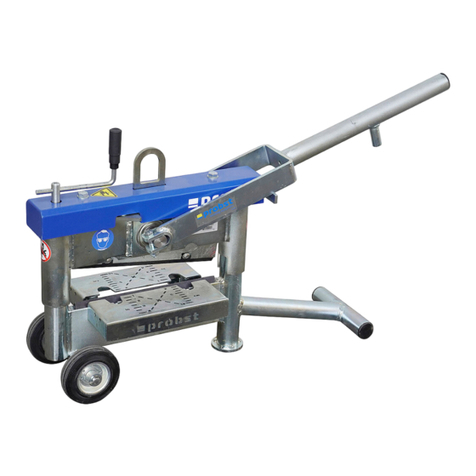
probst
probst STS-EASY operating instructions
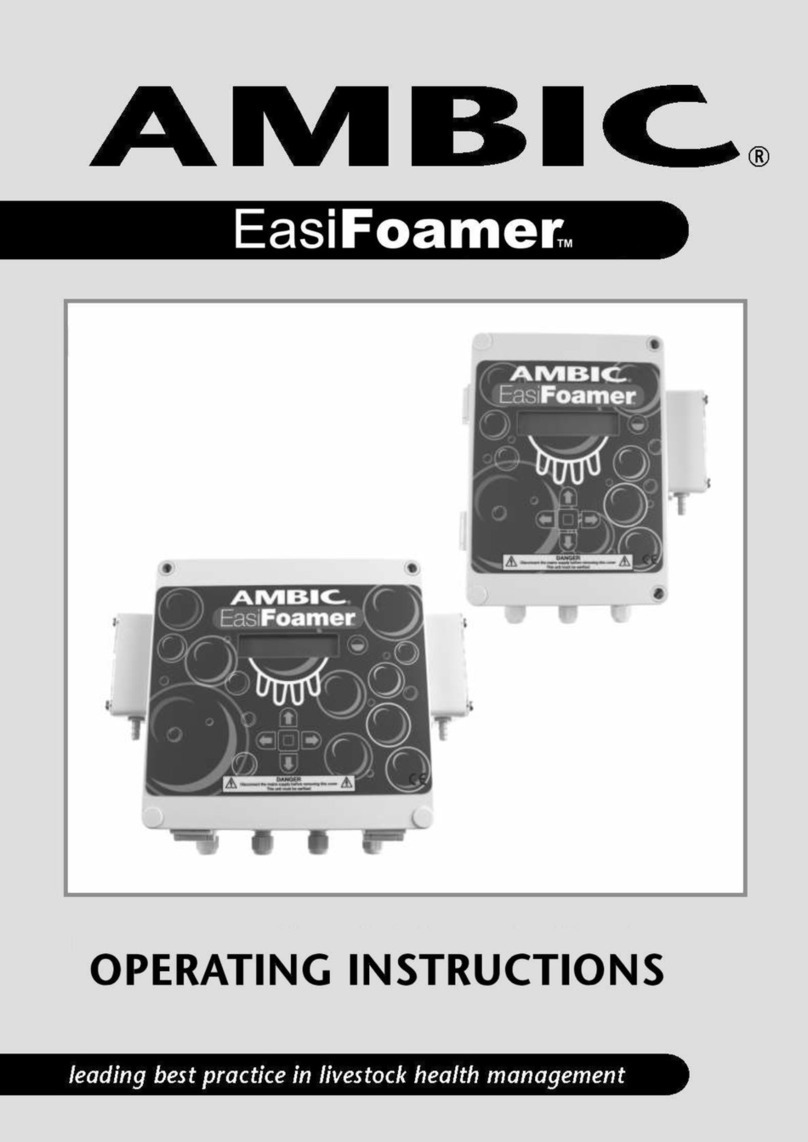
AMBIC
AMBIC EasiFoamer operating instructions
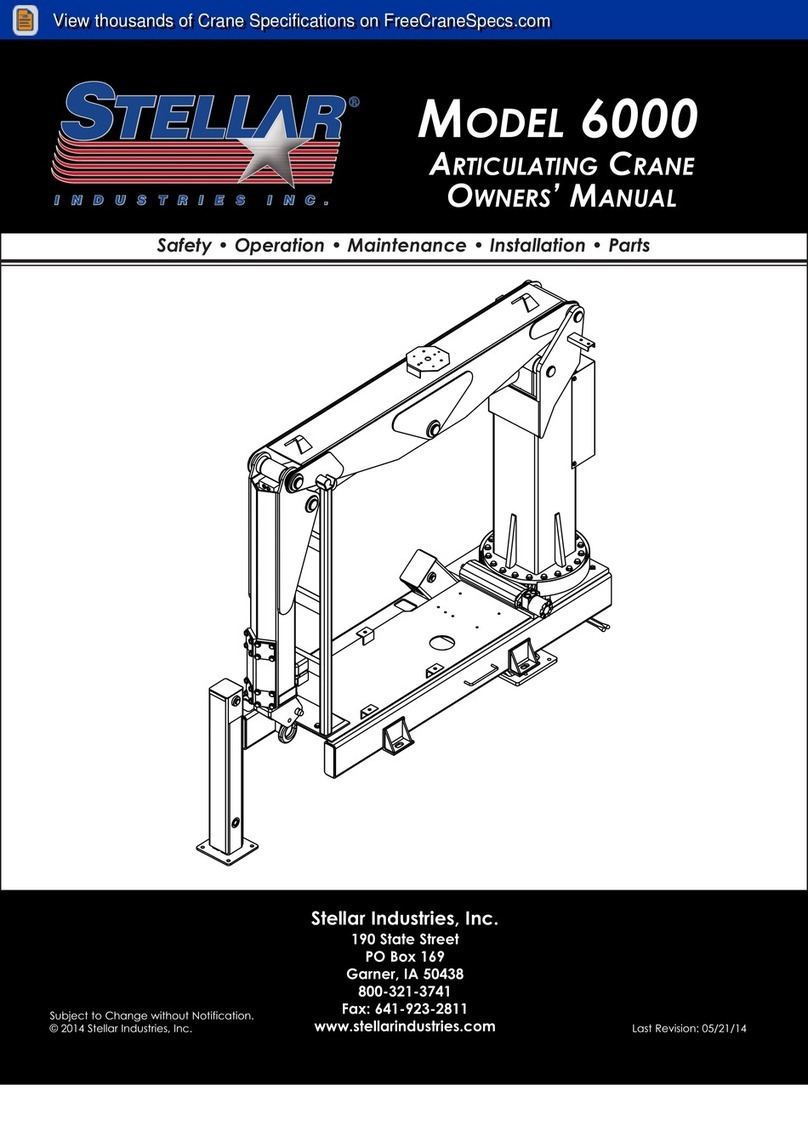
stellar labs
stellar labs 6000 owner's manual
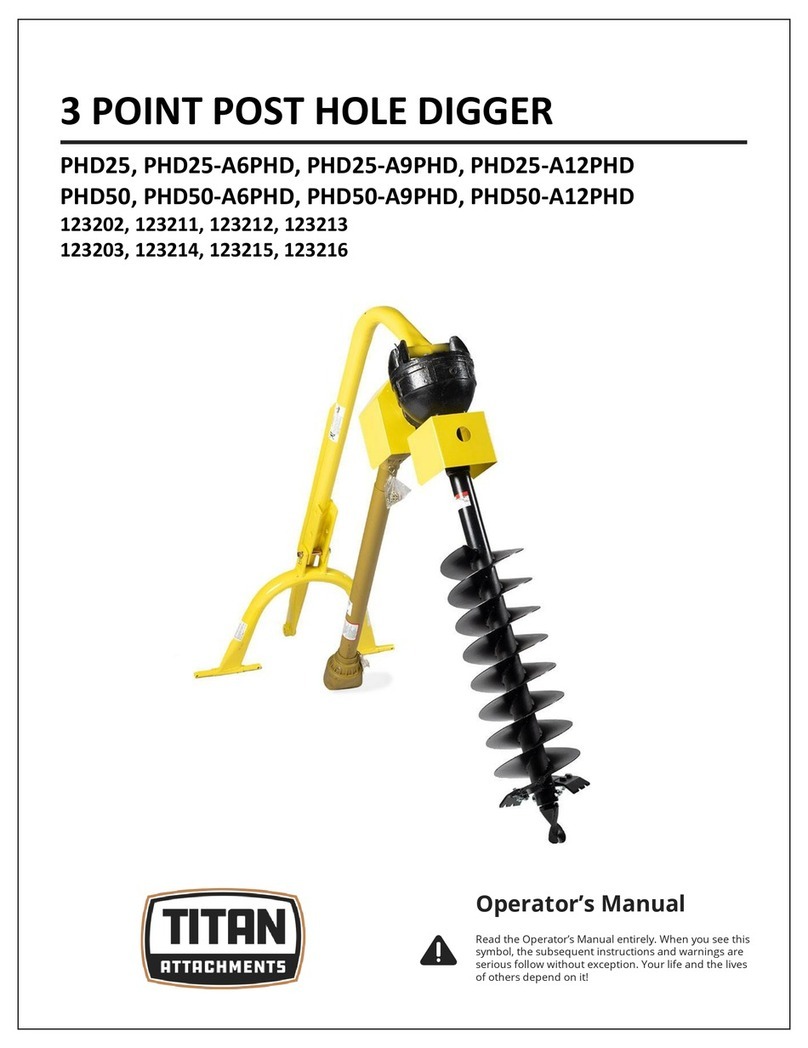
Titan Attachments
Titan Attachments PHD25 Operator's manual
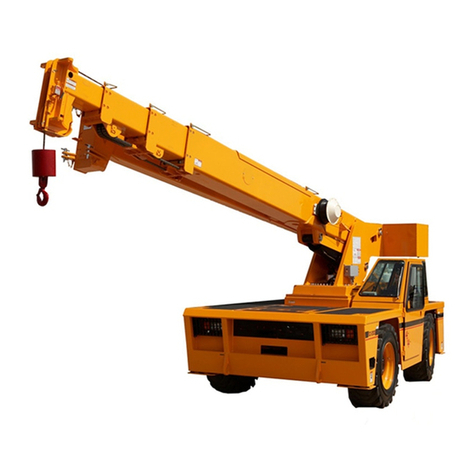
Broderson
Broderson IC-200-2J Operation and maintenance manual
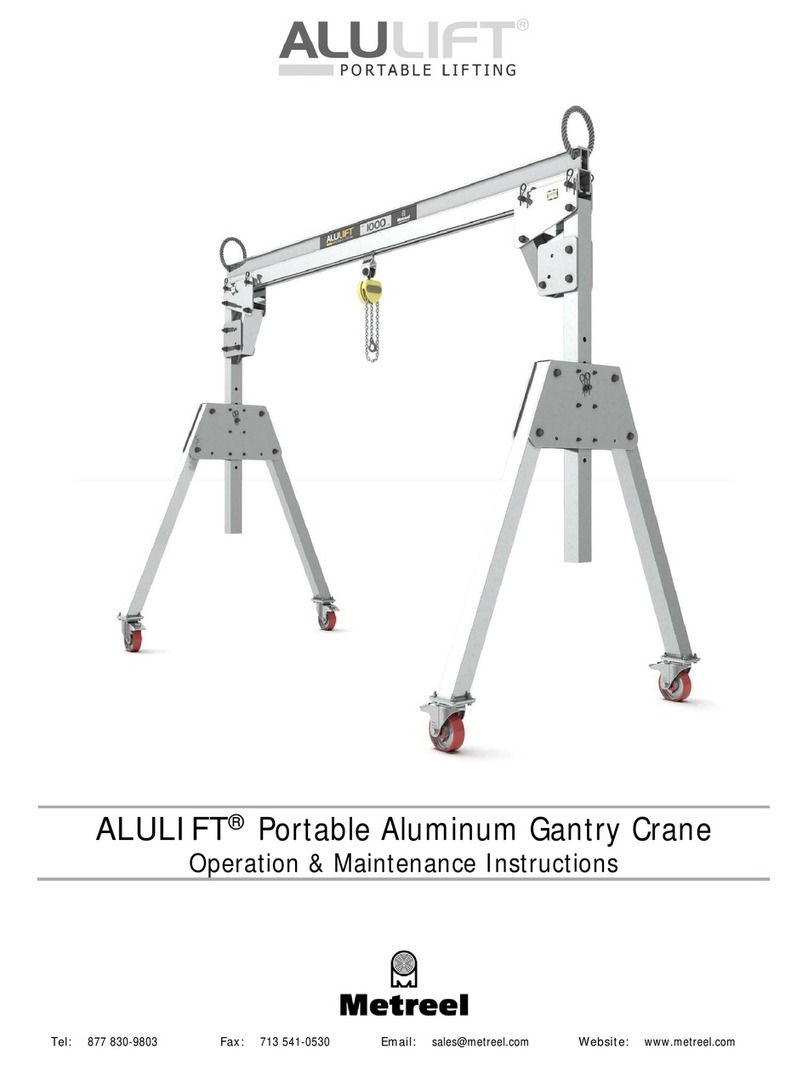
Metreel
Metreel ALULIFT Operation & maintenance instructions
